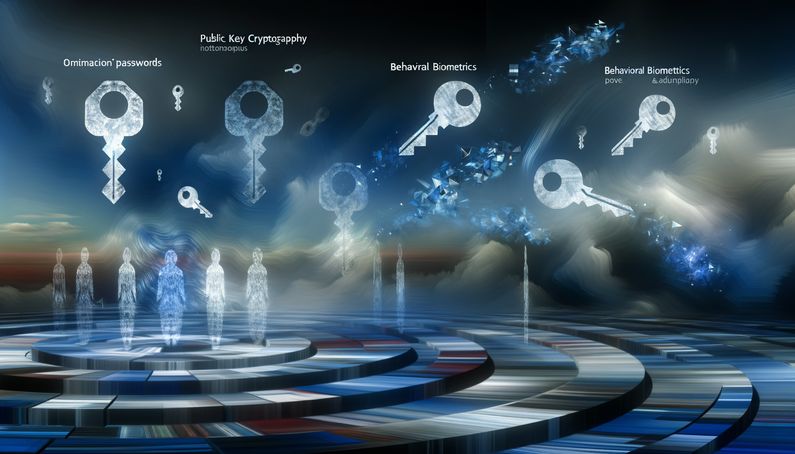
The Future of Authentication: Beyond Passwords
Passwords have long been the gatekeepers of our digital lives, but their reign may be coming to an end. With the rise of cyber threats and the increasing sophistication of hackers, the need for more secure and user-friendly authentication methods is more pressing than ever. Enter emerging technologies like passkeys, biometric authentication, and blockchain, which promise to revolutionize how we protect our online identities. Passkeys, for instance, leverage public key cryptography to offer a secure alternative to traditional passwords, supported by tech giants like Google, Apple, and Microsoft. Meanwhile, biometric authentication is evolving beyond fingerprints and facial recognition to include behavioral biometrics, which analyze user interactions with devices for added security. As these technologies gain traction, they offer a glimpse into a future where passwords might become obsolete.
Emerging Technologies: Alternatives to Passwords
Passkeys and Public Key Cryptography
Passkeys, based on the FIDO2 standard, are emerging as a promising alternative to traditional passwords. They utilize public key cryptography to authenticate users, offering a more secure and user-friendly experience. Unlike passwords, passkeys are resistant to common attack vectors such as phishing and credential stuffing. This is because the private key used for authentication is stored securely on the user’s device and is never transmitted over the internet. Therefore, even if a hacker intercepts the communication, they cannot access the private key. Passkeys are now supported by major platforms including Google, Apple, and Microsoft, making them a viable option for widespread adoption.
Biometric Authentication: Beyond Physical Attributes
Biometric authentication, which uses unique physical attributes like fingerprints or facial recognition, has been around for some time. However, the focus is shifting towards more advanced forms of biometric authentication that incorporate behavioral biometrics. Behavioral biometrics analyze how a user interacts with their device, such as typing rhythm or mouse movements, to verify identity. This method offers significant advantages in terms of convenience and security. Since behavioral patterns are difficult to replicate, they provide an additional layer of security. However, there are concerns about data privacy and the cost of implementation. Despite these challenges, the technology is gaining traction as a reliable alternative to passwords.
Security Keys: A Physical Approach to Digital Security
Security keys are physical devices that provide an additional layer of security through multi-factor authentication (MFA). These keys, which can be USB, NFC, or Bluetooth-enabled, require users to physically authenticate their identity. While traditionally used in conjunction with passwords, some platforms now support password-less logins using security keys. This method is particularly effective because it requires physical possession of the key, making it difficult for attackers to gain unauthorized access. According to Bleeping Computer, support for password-less logins using security keys is currently available in Windows, indicating a shift towards more secure authentication methods.
Blockchain for Secure Data Storage
Blockchain technology, known for its use in cryptocurrencies, is being explored as a method for secure password storage. The decentralized nature of blockchain offers an incorruptible way to store data, making it an attractive option for securing credentials. By distributing data across a network, blockchain reduces the risk of centralized attacks. However, there are concerns about the cost and complexity of implementing blockchain for password storage. Despite these challenges, the potential for blockchain to revolutionize data security is significant, and ongoing research aims to address these issues.
Zero-Knowledge Proofs: Proving Without Revealing
Zero-knowledge proof (ZKP) technology offers a novel approach to authentication by allowing users to prove their identity without revealing their actual credentials. This cryptographic method ensures that users can authenticate themselves without transmitting sensitive information over the internet. The National Institute of Standards and Technology (NIST) notes that ZKP provides a secure way to verify identity while minimizing the risk of data breaches. However, the technology requires significant processing power and may be complex to implement. As research continues, ZKP holds promise as a secure alternative to traditional passwords.
Passphrases: Enhancing Security Through Complexity
Passphrases are an evolution of traditional passwords, offering enhanced security through increased complexity. Unlike passwords, passphrases consist of longer strings of words or characters, making them more resistant to brute-force attacks. The extended length of passphrases exponentially increases the number of possible combinations, providing a higher level of security. However, they still rely on user-generated input, which can be a vulnerability if common phrases or predictable patterns are used. Despite this limitation, passphrases are a simple yet effective way to improve security.
Multi-Factor Authentication: Layering Security Measures
While not a direct replacement for passwords, multi-factor authentication (MFA) enhances security by requiring multiple forms of verification. MFA can include a combination of something you know (password), something you have (security key), and something you are (biometric data). This layered approach makes it more difficult for attackers to gain unauthorized access. However, MFA is not without its vulnerabilities. Techniques such as prompt bombing or adversary-in-the-middle attacks can exploit weak passwords, highlighting the importance of robust password creation. Despite these challenges, MFA remains a critical component of modern security strategies.
Behavioral Biometrics: A New Frontier in Authentication
Behavioral biometrics represent a new frontier in authentication, focusing on how users interact with their devices. This method analyzes patterns such as typing speed, mouse movement, and even how a device is held. The advantage of behavioral biometrics lies in their ability to provide continuous authentication, constantly verifying the user’s identity throughout a session. This reduces the risk of unauthorized access if a device is left unattended. However, the implementation of behavioral biometrics raises concerns about data privacy and the potential for false positives. Despite these challenges, the technology offers a promising alternative to traditional authentication methods.
The Role of Artificial Intelligence in Authentication
Artificial intelligence (AI) is playing an increasingly significant role in authentication processes. AI algorithms can analyze vast amounts of data to identify patterns and anomalies, enhancing the accuracy and reliability of authentication systems. For instance, AI can be used to detect unusual login attempts or identify potential security threats in real-time. This proactive approach allows for quicker response times and reduces the risk of data breaches. However, the use of AI in authentication also raises ethical concerns, particularly regarding data privacy and the potential for bias in AI algorithms. As AI continues to evolve, it will play a crucial role in shaping the future of authentication.
The Future of Passwords: A Hybrid Approach
While emerging technologies offer promising alternatives to passwords, a hybrid approach may be the most effective solution. Combining traditional passwords with advanced authentication methods such as biometrics, security keys, and AI-driven analysis can provide a robust security framework. This multi-layered approach addresses the limitations of individual methods and offers a comprehensive solution to modern security challenges. As technology continues to evolve, the integration of these emerging technologies will be essential in creating a secure digital landscape.
In conclusion, while passwords have been the cornerstone of online security, emerging technologies offer promising alternatives that address their limitations. From passkeys and biometric authentication to blockchain and AI, these innovations are shaping the future of authentication. As these technologies continue to develop, they hold the potential to significantly enhance security and user experience in the digital age.
Final Thoughts
The future of passwords is not just about replacing them but enhancing them with a hybrid approach that combines the best of emerging technologies. By integrating passkeys, biometric authentication, and AI-driven analysis, we can create a robust security framework that addresses the limitations of traditional methods. As noted by Bleeping Computer, the shift towards password-less logins using security keys is already underway, signaling a move towards more secure authentication methods. While challenges remain, such as privacy concerns and implementation costs, the potential benefits of these technologies are significant. As we continue to innovate, the goal is to create a digital landscape where security is seamless and user-friendly, paving the way for a safer online experience.
References
- Bleeping Computer. (2024). The 7 technology trends that could replace passwords. https://www.bleepingcomputer.com/news/security/the-7-technology-trends-that-could-replace-passwords/



